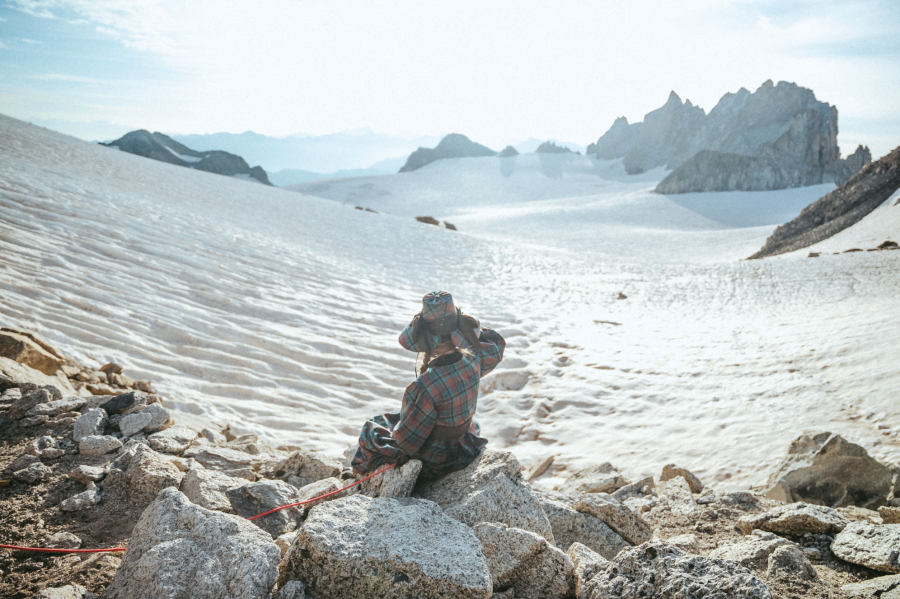Main image: This woman with altitude enjoys the views towards the Matterhorn from the Glacier du Tour | Credit: Grace Taylorson Smith Pritchard
For the modern-day mountaineer wishing to summit Mont Blanc, the recommended packing list is extensive. Full shank insulated climbing boots, a warm down jacket, a waterproof hard-shell jacket, lightweight Gore-Tex trousers, polarised sunglasses…the list goes on.
My own attempt at climbing Europe’s highest peak wouldn’t involve any of this fancy kit. I would be in a unique, homemade ensemble, a replica of that worn by the first woman to climb the mountain unaided in 1838. As I waited to board the train to Chamonix, surrounded by my bags overflowing with green and blue wool plaid and a rather fetching bonnet, I genuinely wondered what on earth I’d got myself into.
Unknown and unaided
The story began eight months earlier, when I read about Henriette d’Angeville while researching Woman with Altitude, an ongoing project of mine which highlights and follows in the footsteps of overlooked women adventurers. Henriette was the first woman to climb Mont Blanc ‘unaided’, (Maris Paradis had attempted the climb 30 years earlier, but was carried to the summit due to altitude sickness). She was a pioneer, but like many of the women I’ve researched, I was surprised by how few people knew her name.
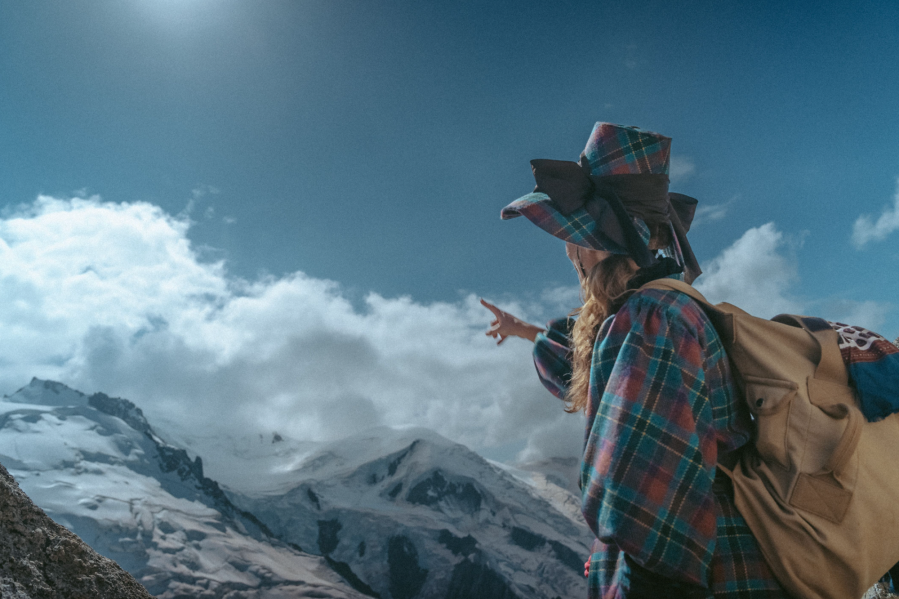
Historically, mountaineering has been a man’s world. In her forward to Henriette’s memoir My Ascent of Mont Blanc, cyclist and writer Dervla Murphy explains that “Henriette d’Angeville was not only challenging Europe’s highest mountain, but a degree of prejudice that would have defeated most people. Ladies were not supposed to do Things Like That.”
On top of societal pressures, clothing was also a barrier for women who dared to adventure. Even now, women are held back by ill-fitting clothing, designed and made by and for men. Bloomers came into fashion in the 1850s, but it wasn’t until the 1870s – when the bicycle became more mainstream but was too impractical to ride in corsets and dresses – that women won the battle to wear trousers in public. 20 years before, when Henriette bravely stepped out into Chamonix’s central square sporting her home-made woollen trousers and confronted by ‘looks from a disapproving crowd’, she was blazing a trail beyond mountaineering.

For women like Henriette, the only option was to create an outfit they hoped might offer some comfort and practicality, so I decided to follow in her footsteps. We can never truly understand the difficulties and barriers women of the past faced on their journeys if we are equipped with modern gear. Basing my own Mont Blanc ensemble on Henriette’s detailed record, I began to piece it all together.
Dressed to Ascend
Henriette’s packing list included two pairs of silk stockings, hobnailed boots, a feather boa, a pair of Scottish wool trousers with a fleece lining, a blouse and bonnet both of the same material as the trousers, a long stick with a ferrule, one pair of gloves, a leather belt, a plaid, a pelisse, and a black velvet mask – a common way to protect from sunburn.
On top of her clothing, Henriette took a further 20 items, which included a telescope, a looking glass, cucumber pomade (to treat sunburn), a friction brush and an enormous fan!
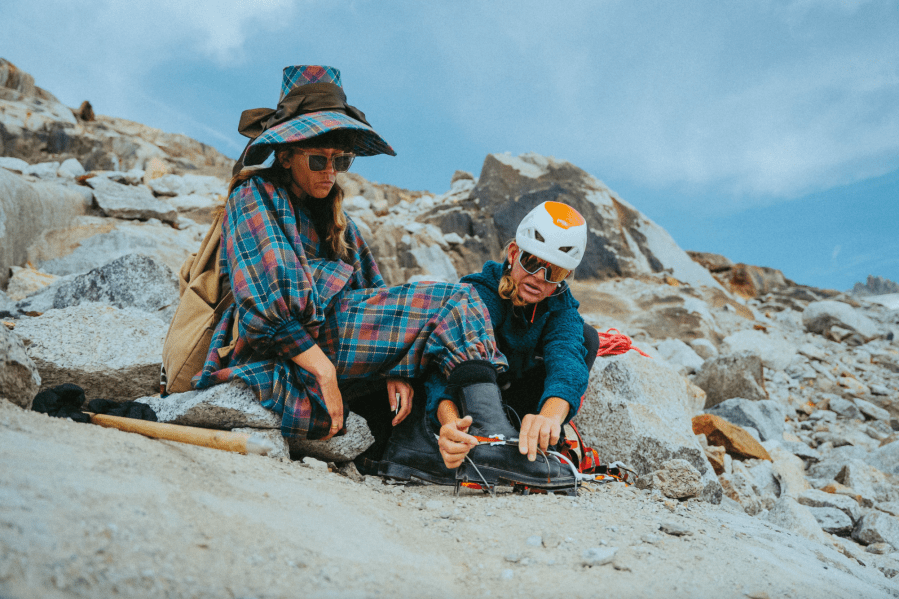
I learnt that crampons didn’t really exist in 1838, so extra porters would often travel with climbing groups to cut steps in the ice. This explains why Henriette’s group thought it necessary to take six porters on their three-day expedition, along with an abundance of food which included 24 roast chickens, 18 bottles of Saint-Jean wine, two legs of mutton, two sides of veal and six loaves of bread. This seems wildly excessive to us now, and while early mountaineers clearly had rich tastes to match their pockets, they also had no satellite phones or weather apps, and so would pack extra resources should their journeys take longer than planned.
For my own arrival in Chamonix, I was greeted with unprecedented warm temperatures, threatening our summit attempt. As the permafrost on the mountain melts, sections of the climb become increasingly dangerous due to rockfall, so we opted to spend our first few days trying out my ‘old fangled’ gear.
Acclimatisation
Joined by mountain guide Karen Bockel and filmmaker Grace, we climbed to the Refuge Albert Premier hut perched on the Glacier du Tour, which overlooks Chamonix town. In the dark basement at 4AM, I watched my fellow climbers, warm and cosy in their down jackets, slip on their climbing boots with ease.
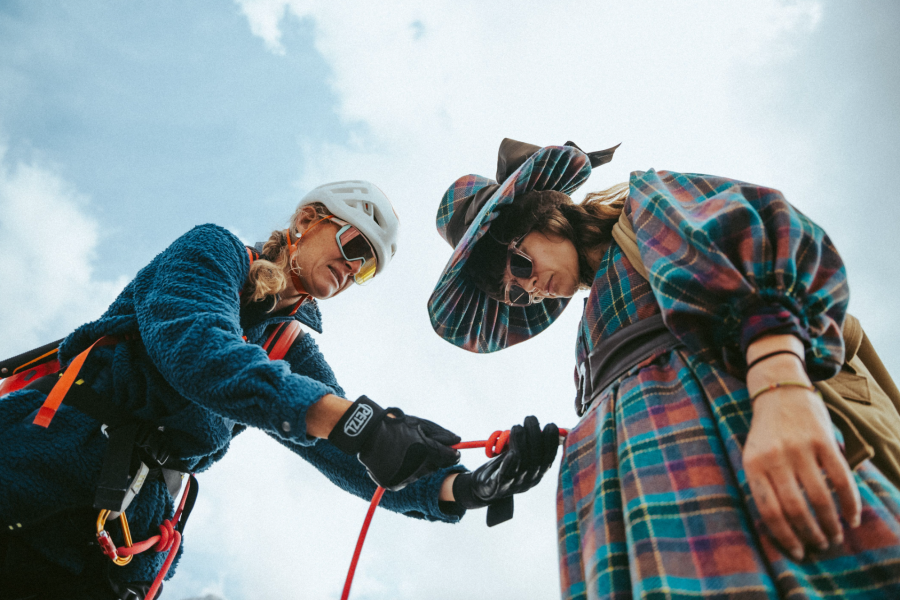
My own hobnail leather boots, specially made by Trickers, the oldest show company in the UK, looked frail in comparison, and as I pulled my wool dress and trousers on over my Victorian cotton undergarments, I could feel all the eyes staring at me through the hazy light. Last on was the boa and bonnet, and I stepped out onto the glacier towards the famous Aiguille du Tour.
Last on was the boa and bonnet, and I stepped out onto the glacier towards the famous Aiguille du Tour…
The rising sun glistened on the sharp point of my ferrule. I watched as it pierced deep green glacial ice, securing me with each step. Although not lightweight by any stretch, it felt just as practical as the modern walking poles of my fellow climbers. Surprisingly, my hobnail boots came into their own on the rocks and ice, and I soon found a rhythm, trusting them more with every step. On the steeper ice sections, I would slip them into modern crampons, as we’d neglected to bring along the six male porters to chisel steps.

With the full morning sun now bearing down on us, I had my first taste of the heavy wool layers. With the sweating came the itching, and I longed for modern breathable tops and lightweight jackets… with zips! Yet to my surprise the wool was water resistant and could handle lots of snow before the damp permeated. The last, technical section of the climb revealed the cumbersome nature of the bonnet, which must have been a bane for early women mountaineers. Impossible to see up or down, the brim would hit the rocks when I turned my head. I resorted to climbing tilted slightly backwards, which didn’t feel like the safest technique.
In her shoes
A sudden drop in temperature allowed us to take our chance at the summit. With Henriette in my mind, I stepped out into the centre of Chamonix, 186 years to the day after she took the same first steps. The scratching of hobnails on paving stones still turned heads.
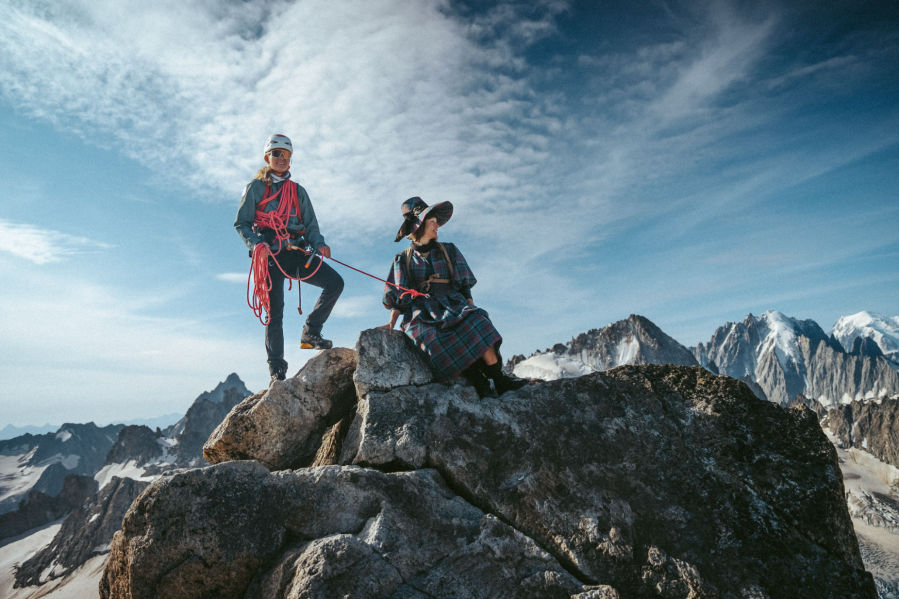
I had initially planned to walk all the way from Chamonix to the summit of Mont Blanc, but with a short weather window and a storm on the way, we decided to join the other climbers in the cable car from Les Houches. With the hobnails slipping across the metal walkways and grinding on concrete, we then took the Tramway du Mont Blanc to the Nid d’Aigle where we would begin our ascent.
Gore-Tex clad climbers overtook us and disappeared into the distance as we began the painstaking climb to the Tet Rousse hut. The air was thick with moisture and soaked through my clothing, and as we gained height the rain fell with more force. My feet were painful and blistered from our training days, and my slow pace became a concern as angry clouds gathered. I concentrated on each step, careful not to slip on the sharp brown rocks.
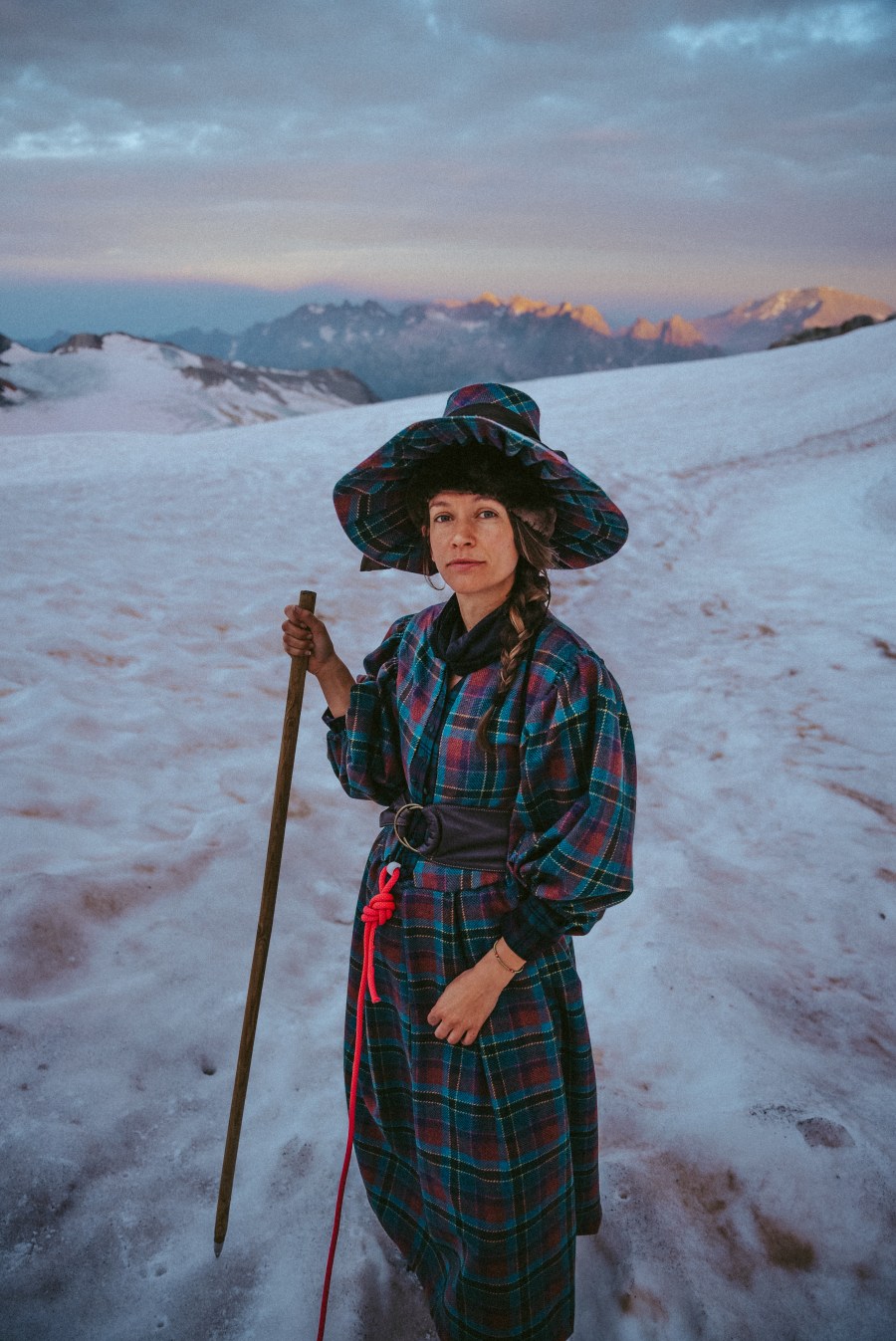
That night, I sat comparing my outfit to those around me. The neon colours, the rustling of plastic, the gear-offs between the men. I thought about how climbing in natural materials enables me to immerse myself in the environment, with no modern equipment or gadgets for distraction. I feel the rain and the snow and understand the roles they play in the mountain’s ecosystem. Although impractical, climbing in the clothing and equipment of the day not only offers insight into the barriers that women like Henriette faced, but also connects me on a deep level to the mountain.
As we readied ourselves at 3AM the next morning, Karen delivered the bad news. The storm was here, and I would never make it to the summit and down again in time, laden with my old gear. There had been fatalities on the mountain the day before, and heartbroken as I was, I realised that we would have to turn back. Watching the trails of headlights ascend above us, I wondered how they would fare if they too were stripped of their modern luxuries.
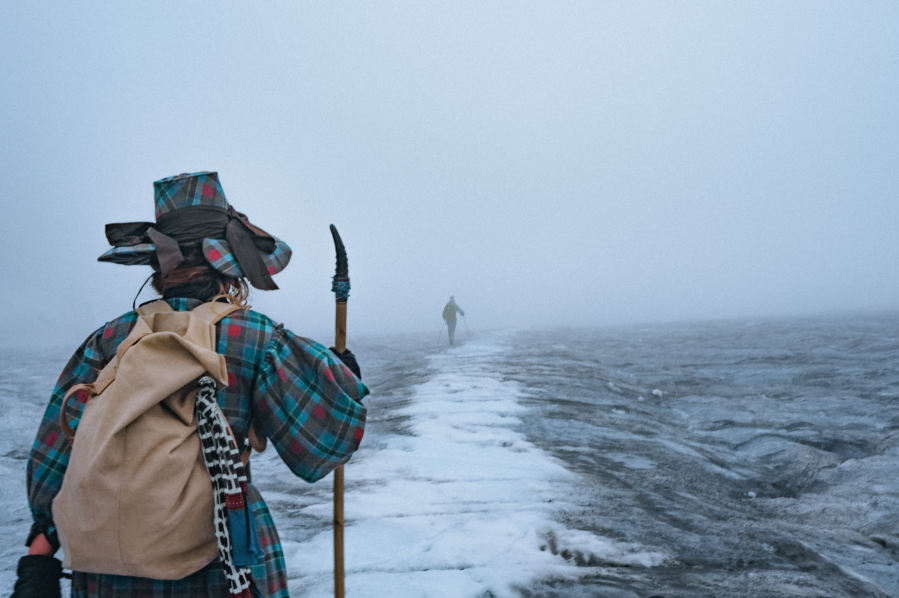
More than the summit
Slowly descending, my mind racing, I still wanted to celebrate Henriette in some way. We turned to the Oldenhorn in Switzerland, as the last mountain Henriette summited, age 69. Exhausted, we drove to the base of the mountain, now a large car park with a cable car that delivers tourists to the glacier and ski area above. I wanted to walk, like Henriette would have done, so with the buzz of the cable car above us, we ascended through lush alpine pasture, the chime of cow bells distracting me from the last painful push in the hobnail boots.
Despite not being the summit I had hoped for, this adventure was about more than reaching the top. Women like Henriette are still missing from our mainstream mountain history, which does both them and women today a grave disservice. By recreating their journeys in this way and immersing myself in their world, I believe we can learn valuable lessons from the women who went before us, especially around resilience and bravery. Both are much needed when it comes to climbing mountains in bloomers and bonnets.
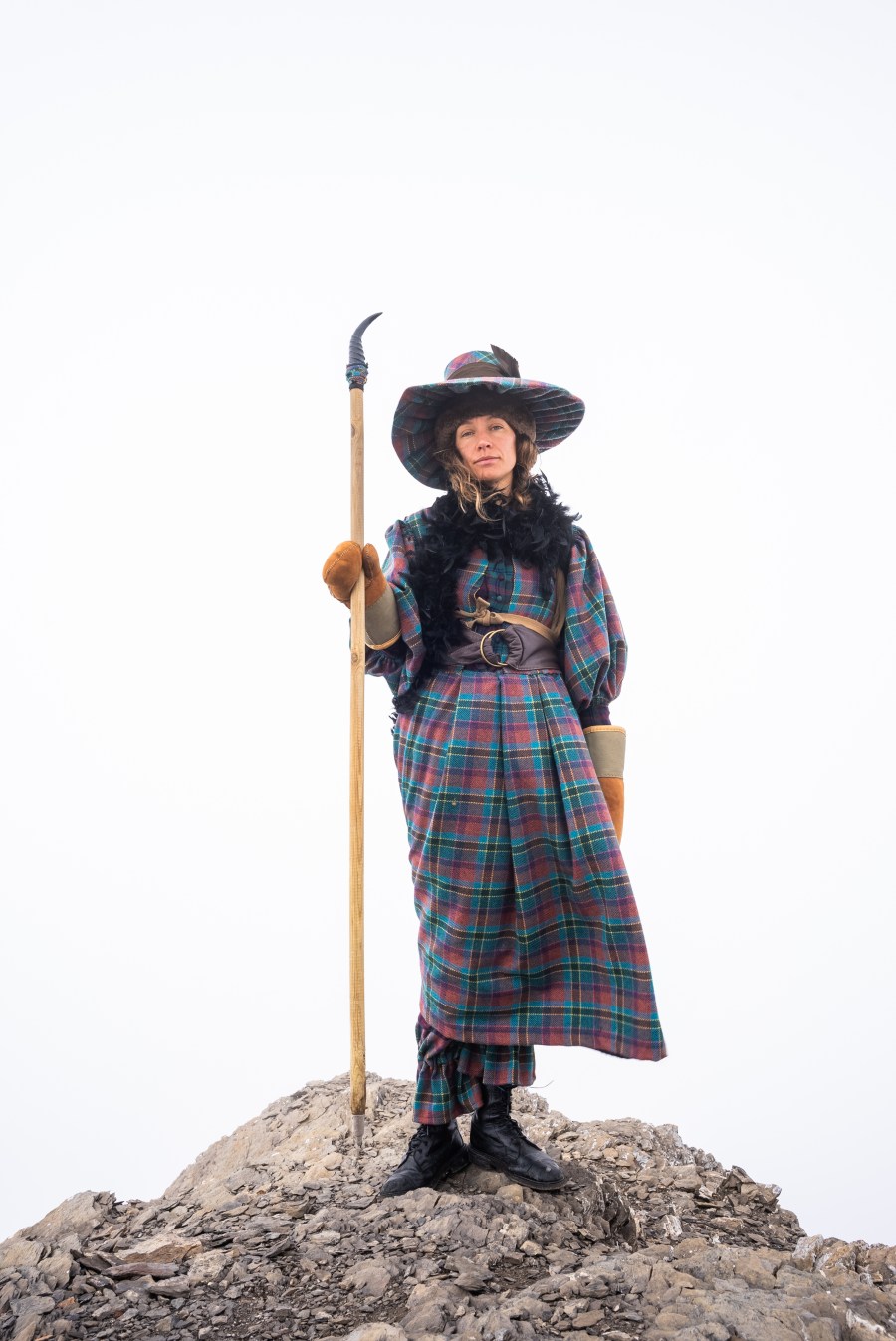
Elise’s Mont Blanc clothing list
- A foulard cravat
- Two pairs of silk stockings
- Two pairs of thick woollen stockings
- Leather nailed boots
- One pair of trousers, cut full and corded at the top, made of Scottish wool plaid
- A blouse and skirt of the same material as the trousers
- A leather belt
- One pair of large fleece lined gloves
- A boa
- A close bonnet of the same material as the trousers
- A black velvet mask
- A long stick with a ferrule
- A plaid (a large piece of material worn over the shoulder)
- A Pelisse of the same material as the trousers (a close-fitting overdress)
Woman with altitude: A head for heights
Elise Wortley’s project Woman with Altitude highlights overlooked women adventurers from history, who achieved astonishing feats but were not celebrated like their male counterparts. Bringing to life these women’s incredible stories by literally walking in their footsteps, Elise re-creates their expeditions using only what was available to them at the time. She has learnt that travelling without any modern expedition gear, waterproof clothing, or indeed, modern-day sports bras adds a whole new level of complexity.
Learn more at www.womanwithaltitude.com
This feature was first published in the March 2025 issue of The Great Outdoors which is dedicated to mountain women. To read more of their stories, you can buy a single back issue of the magazine here.

